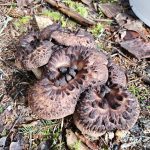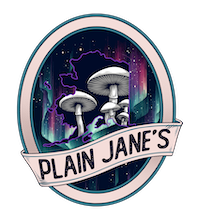Foraging is what inspired Plain Jane’s. Getting lost in the woods, walking on the soft spongy moss, the fresh earthy smell, and finding beautiful mushrooms was all part of the inception of what is now Plain Jane’s.
Mycology Guests
Skagway was recently honored to have the Desert Alchemist (Hernan Castro) come to our remote part of the world and share his mushroom knowledge. Hernan led two forays & two classes with participants of varying levels of foraging experience. Everyone walked away from our hikes with delicious edible mushrooms and a better understanding of identification, ethical foraging, and hopefully a deeper appreciation for the forest around us.
During the foraging hikes Plain Jane’s was excited to share this experience with local mushroom enthusiast, Annemarie of Glacier Naturals and Hernan’s hosts, the Klupar family of the Skagway Historic Inn. 

***mushrooms in photo bleeding tooth fungus (hydnellum peckii)***
How Forest Support Mushroom Growth
It is important to care for the earth. The world around us has so much to offer but we need to do our part in caring for the forest. Forests are complex environments and mushroom growth is influenced by several factors including:
Biodiversity: many different tree, shrub and undergrowth species
Soil composition: rich nutrient dense soil, some mushrooms prefer acidic soils while others like alkaline
Moisture levels: forests have high humidity levels but it does ebb and flow impacting mushroom growth. In the fall (Plain Jane’s favorite harvest time) fallen leaves will help retain moisture that many mushrooms enjoy
Light availability: mushrooms still like to have light but some mushrooms like differing amounts of light, the canopy of the forest creates shade and filters the amount of light entering the forest.
Decomposition: fungi are vital to breaking down organic matter, decaying wood, leaves and other material create an ideal environment for mushrooms
Symbiotic relationships: some mushrooms form what is known as a mycorrhizal association with tree roots, the mushroom and the tree share nutrients improving growth for both the mushroom and tree. In mushroom identification noting what trees are nearby is helpful for proper identification because of this factor.
Temperature: due to the density in the forest temperatures are more stable which also supports mushroom growth. Seasonal temperature changes due to the also can induce mushroom fruiting.
 Due to all those factors it is important we protect our forests. Every part of the forest is interconnected. Harvesting mushrooms should only be done in a respectful and forest friendly manner. At Plain Jane’s we follow the following rules:
Due to all those factors it is important we protect our forests. Every part of the forest is interconnected. Harvesting mushrooms should only be done in a respectful and forest friendly manner. At Plain Jane’s we follow the following rules:***mushroom in photograph hawkswings (sarcodon imbricatus) ***
Foraging Guidlines
1. Know your mushrooms, if you plan to eat your forest finds be safe! Please, do not rely on apps, books or guesses, only consume what you KNOW is safe, one of the best sources is another myco enthusiast. iNaturalist is a great resource with scientists at work behind the scenes but is not fool proof either.
2. Limit impact: only forage where it is allowed, know who’s land you are on, avoid over harvesting
3. Leave NO trace, pack in, pack out! Take pictures (properly identified safe mushrooms & not over harvested mushrooms), leave thoughtful footprints
4. respect wildlife: since we forage in Alaska we are always bear aware!
5. Be mindful of soil health which is key to mushroom development. Avoid disturbing the forest floor which is the home to the mycelium networks mushrooms grow from, as little impact as possible.
Plain Jane’s hopes everyone is safe and enjoying the fall mushroom season!
